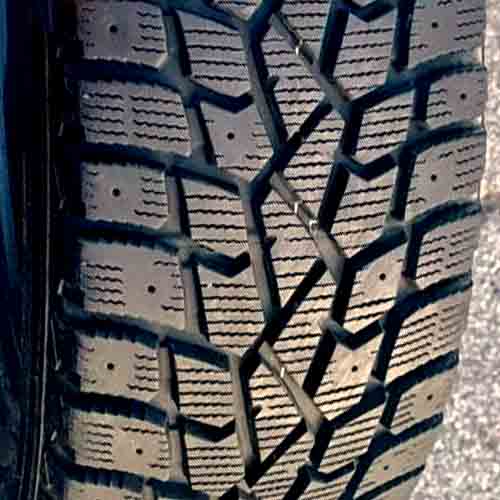Both Sumitomo Ice Edge and Nokian Nordman 7 are worth mentioning in the winter tire spectrum, each with unique attributes to tackle the toughest winter conditions. But which tire is better for your needs? Well, let’s find out.

Table of Contents
Key Takeaway
The Nokian Nordman 7 (review) stands out when it comes to:
- Ice Traction: With multiple smaller biters, variable-width inclined cuts, dual siping patterns, and highly angled biters, the Nokian Nordman 7 delivers superior traction on icy terrains.
- Wet Performance: The tire has various types of sipes and a relatively softer compound, which allows for better absorption and redirection of water, hence enhancing grip on wet roads.
- Dry Gripping: The Nokian Nordman 7, with a denser central rib, ensures continuous surface contact during linear motion, leading to improved performance in dry conditions.
- Fuel Efficiency: The tire’s streamlined lugs and less aggressive central tread voids contribute to smoother, uninterrupted central rib motion, leading to better fuel economy.
- Vibration Dampening: The tire, with a softer rubber compound, enhances the flexibility of its lugs, effectively absorbing impacts and mitigating surface vibrations.
On the other hand, the Sumitomo Ice Edge excels in:
- Snow Grip: The Sumitomo performs better in fluffy or powdery snow conditions due to its abundant notches and voids in the tread that act as snow catchers, improving ground contact by holding onto the snow.
- Tread Life: Despite carrying a smaller tread depth, the tire delivers superior tread life due to its stiffer rubber compound, which wears at a slower rate.
Available Sizes
The Sumitomo Ice Edge comes in 14 to 20 inches with following.
- Speed ratings: T only.
- Load ratings: SL and XL.
- Tread depth: 12/32″ on all.
- Weight: 16 to 33 lbs.
On the other side, the Nokian Nordman 7 comes in 34 sizes in 13 to 17 inches rims, with following specs.
- Speed ratings: T only.
- Load ratings: SL and XL.
- Tread depth: 13/32″ on all.
- Weight: 15 to 27 lbs.
- Tread warranty: None.
Dry Gripping
The efficacy of the directional grip is largely dependent on the central tread area, as it defines the extent of contact between the tire and the road.
When the tire travels in a straight line, this central area bears the most pressure. And yes, that’s the reasons why its measured through braking distances (and also acceleration times, in some cases).
And so considering that, it can be understood, why out of both tires, the Nokian Nordman, armed with a denser central rib, ensures continuous surface contact during linear motion, leading to superior performance.
Whereas the Sumitomo with wider laterally oriented voids isn’t able to keep up, exhibiting on average, a braking distance seven feet longer in tests.
Dry Handling
The handling attributes of a tire are largely influenced by the shoulder regions. During cornering, the tire’s weight shifts towards the tread edges.
This is why the Nokian, equipped with more condensed shoulder blocks, delivers better performance.
Though the tire can still improve its steering feedback a little bit, as it’s softer compound, despite having lighter structure weight causes lug bending, a phenomenon, which disturbs the balance between understeer and oversteer, causing the tire’s relative handling performance to get limited slightly.
Ice Traction
When traversing icy terrains, numerous smaller biters distributed across the tread are crucial, which elucidates why the Nokian tire here, exhibits superior ice gripping efficacy.

The tire’s complex features, including variable-width inclined cuts, paired with dual siping patterns, and highly angled biters, all converge to deliver comparatively outstanding performance.
Conversely, the Sumitomo, with its broader tread voids, struggles to achieve the same efficacy in gripping ice.
The absence of notches and multi-angled siping on both central and shoulder lugs contributes to extended average braking distances and handling times.
Though if you consider using studs on the tire, it’s overall traction almost becomes equal to that seen on its counterpart.
Snow Grip
Under snowy conditions, the Sumitomo Ice Edge is superior tire to have, comparatively.

The tire simply deals with less packed up, you can say, fluffy, or powdery snow much better (than it does with ice). This is because it’s tread contains abundant notches and voids acting as snow catchers, enhancing ground contact by holding onto the snow.
This phenomenon is due to snow’s stronger tendency to stick to itself rather than rubber.
On the flip side, the Nokian Nordman 7, with its less spacious and simplistic tread design, can’t facilitate as effective snow-to-snow contact, particularly in heavy snow. So overall handling and braking efficacy on this terrain is limited for this tire.
Wet Performance
Tire’s gripping efficacy on damp surfaces primarily depends on the number of voids, a tread has.
The major grooves, like the block voids provide resistance to hydroplaning, while the sipes, and other tread features, help in clearing of water at a micro level.
Now of course, being winter tires, both tires have plenty of such biters, but still overall, the Nokian Nordman 7 takes the lead by a tiny margin.
This tire basically incorporates varied types of sipes which are more proficient at soaking up and redirecting water, enhancing grip on wet roads.
Moreover, the tire also features a relatively softer compound, so sipes are better able to breath water in and out.
The Sumitomo on the other side, displays less assertive siping and a stiffer rubber compound, lacking to its counterpart.
Tread and Fuel Usage
The correlation between tread life and fuel economy is largely determined by rolling resistance, significantly influenced by the tire’s weight, tread composition, and design.
Regarding fuel efficiency, the Nokian Nordman 7 outperforms, owing to its more streamlined lugs and less aggressive central tread voids.
This design allows for a smoother, uninterrupted central rib, minimizing hindrances during linear rolling, and thereby enhancing fuel economy.
However, in terms of tread life, the Sumitomo Ice Edge prevails. This is because, the tread life is shaped by two factors: the rate of rubber wear and the time taken to reach a critical wear level.
Now, although the Sumitomo isn’t lighter, and the tire carries smaller tread depth, the tire still does better, thanks to its relatively stiffer rubber compound.
(Deeper tread means a longer time to reach the legal 2/32″, though in this tire’s case, its not getting too affected by it).
Vibration Dampening
Tires act as auxiliary suspension systems for vehicles, cushioning the immediate impacts derived from road inconsistencies.
In this context, the Nordman 7 stands out with its unique design, as it features a softer rubber compound that enhances the flexibility of its lugs.
This means any impact on the tread is effortlessly absorbed, transforming into the deformation of the lugs, which helps avoid a shaky ride.
The Sumitomo Ice Edge, in contrast, offers a commendable steering response due to its firmer rubber. However, it falls short when it comes to absorbing surface vibrations, owing to its relatively limited capabilities in this area.
Though, its rigid tread significantly contributes to its exceptional performance in terms of overall tread life.
To Sum Up
This thorough comparison highlights each tire’s strengths, with each excelling in different categories. The Nokian Nordman 7 shines in terms of superior wet traction, vibration reduction, and ice performance, while the Sumitomo Ice Edge reigns supreme in snow performance, noise reduction, and dry traction (considerign its superior steering resposne).
Moreover, while the Nokian Nordman 7 excels in fuel economy, the Sumitomo Ice Edge is the champ in tread life.